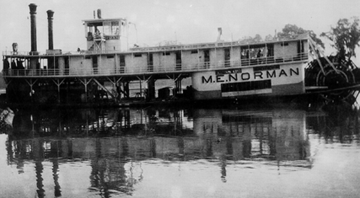|
Help About Related Share Your Story General Mall
Food Court Retail Entertainment Management Souvenirs Related Links
|
ArmyCorpsTimeCapsule
The Sinking of The M. E. Norman Steamship Time CapsuleArtifacts from Corps tragedy discoveredJuly 1998 By Jim Pogue Memphis District A demolition crew recently discovered artifacts from one of the greatest tragedies in the history of the U.S. Army Corps of Engineers.  Twenty-three people died when the Norman sank in 1925. (Photo courtesy of Memphis District) On May 8, 1925, the M.E. Norman, a 113-foot-long sternwheel steamboat, took 72 passengers on a river inspection trip and picnic. The passengers were engineers and their families attending a convention in Memphis, Tenn. In a freak accident at Cow Island Bend just south of the city, the swift current caught the Norman. She drifted crossways to the current and capsized. River worker Tom Lee, in a 28-foot motorboat, was the only eyewitness to the sinking. He rushed to the Norman and personally rescued 32 survivors. In spite of Lee and the efforts of others, 23 people lost their lives. Fast-forward to today. A demolition crew is tearing down the old bridge leading into Ensley Engineer Yard as a new road is built into the facility. As they smash one of the old bridge supports, a small metal box pops out and tumbles to the ground. The workers shut down their heavy equipment to see what they have uncovered. Prying open the expertly soldered copper box, they discover a time capsule containing an oil-soaked flag, passenger list, photos, newspapers, and other artifacts from the sinking of the Norman. The box was originally sealed in a cement column at the entrance to Memphis district's old West Memphis river facility May 12, 1936. When Ensley Engineer Yard was built, the column containing the time capsule was moved and incorporated into the design of the new entrance road bridge. During the years, memory of the time capsule's existence apparently faded. But since its discovery, interest in the time capsule and the Norman has grown. Two newspaper articles have been published, and calls asking for more information have come in from around the U.S. People have phoned to say their parents or grandparents either survived or perished in the sinking, and several callers have offered to share their memories and collection of documents from the incident. Staff archeologist Jimmy McNeil has taken the lead on caring for the artifacts from the time capsule. The oil-soaked Corps flag has been sent to a fabric preservation expert, and the yellowed, fragile documents have been sent to another preservationist who specializes in paper products. Once all of the artifacts have been returned, probably some time this summer, plans are to create an exhibit in the federal building in Memphis. "We've received so many calls from people expressing interest in the Norman, we may try to put together a small history book about the incident," said McNeil. "It would be a shame not to capture some of these memories while we still can." The district plans to hold a ceremony when the proposed exhibit opens, and invite descendants of the Norman's passengers and crew to participate. Museums and history centers in Vicksburg, Miss.; Morgan City, La.; and Nashville, Tenn., have also expressed an interest in borrowing the items for temporary displays in their areas. Norman Exhibit Held In Sept 1998Norman exhibit Memphis District hosted the grand opening of "Time In A Capsule," an exhibit of time capsule artifacts and other memorabilia from the 1925 sinking of the steamer M.E. Norman. The public opening took place Aug. 10 in the Clifford Davis Federal Building in Memphis. L.L. Hidinger, Jr., the only survivor of the tragedy known to still be living, was guest of honor. The exhibit displays the contents of a time capsule unearthed last summer containing artifacts from the Norman, which sank in the Mississippi River just south of Memphis on May 8, 1925. The Norman was carrying 72 visiting engineers, their families, and crew on a tour of the river when the steamer capsized and sank. River worker Tom Less was the only and, using his small motorboat, Lee rescued 32 survivors. Despite his efforts, 23 people lost their lives. The artifacts on display include the oil-soaked Corps flag from the Norman, a copy of the newspaper reporting the sinking, and a variety of photos. Other exhibited items include documents, correspondence, and photos related to the sinking, Tom Lee, and the subsequent investigation. A detailed scale model of the Norman is also on display. The display will run through the end of this month. References |
